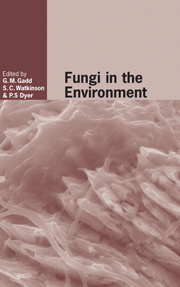Book contents
- Frontmatter
- Contents
- List of contributors
- Preface
- I Imaging and modelling of fungi in the environment
- II Functional ecology of saprotrophic fungi
- III Mutualistic interactions in the environment
- IV Pathogenic interactions in the environment
- 11 Functional genomics of plant infection by the rice blast fungus Magnaporthe grisea
- 12 Exploring the interaction between nematode-trapping fungi and nematodes by using DNA microarrays
- 13 Role of α(1-3)-glucan in Aspergillus fumigatus and other human fungal pathogens
- 14 Plagues upon houses and cars: the unnatural history of Meruliporia incrassata, Serpula lacrymans and Sphaerobolus stellatus
- V Environmental population genetics of fungi
- VI Molecular ecology of fungi in the environment
- Index
- References
12 - Exploring the interaction between nematode-trapping fungi and nematodes by using DNA microarrays
from IV - Pathogenic interactions in the environment
Published online by Cambridge University Press: 03 November 2009
- Frontmatter
- Contents
- List of contributors
- Preface
- I Imaging and modelling of fungi in the environment
- II Functional ecology of saprotrophic fungi
- III Mutualistic interactions in the environment
- IV Pathogenic interactions in the environment
- 11 Functional genomics of plant infection by the rice blast fungus Magnaporthe grisea
- 12 Exploring the interaction between nematode-trapping fungi and nematodes by using DNA microarrays
- 13 Role of α(1-3)-glucan in Aspergillus fumigatus and other human fungal pathogens
- 14 Plagues upon houses and cars: the unnatural history of Meruliporia incrassata, Serpula lacrymans and Sphaerobolus stellatus
- V Environmental population genetics of fungi
- VI Molecular ecology of fungi in the environment
- Index
- References
Summary
Introduction
Soils contain a diverse range of fungi that are parasites on nematodes. They include more than 200 species representing all major taxonomic groups of fungi including deuteromycetes, basidiomycetes, chytridiomycetes and zygomycetes. Nematophagous fungi are found in all regions of the world, from the tropics to Antarctica. They are present in all sorts of soil environments, including agricultural and forest soils (Barron, 1977).
Based on the infection mechanisms, three broad groups can be recognized among the nematophagous fungi: the nematode-trapping and the endoparasitic fungi that attack free-living nematodes by using specialized structures, and the egg- and cyst-parasitic fungi that infect these stages with their hyphal tips (Barron, 1977). The nematode-trapping fungi are the best-known group, probably owing to their remarkable morphological adaptations and their dramatic infection of nematodes. With few exceptions, including the mushroom Hohenbuehelia (asexual state Nematoctonus) (Barron & Dierkes, 1977), the majority of the identified species of nematode-trapping fungi belong to a monophyletic clade among the apothecial ascomycetes (Liou & Tzean, 1997; Ahrén et al., 1998; Hagedorn & Scholler, 1999).
Nematode-trapping fungi can grow as saprophytes in soils. They enter the parasitic stage by developing specific morphological structures called traps. The traps develop from hyphal branches; they can either be formed spontaneously or be induced in response to signals from the environment, including peptides and other compounds secreted by the host nematode (Dijksterhuis et al., 1994). There is large variation in the morphology of trapping structures, even between closely related species (Fig. 12.1).
- Type
- Chapter
- Information
- Fungi in the Environment , pp. 255 - 268Publisher: Cambridge University PressPrint publication year: 2007
References
- 1
- Cited by



